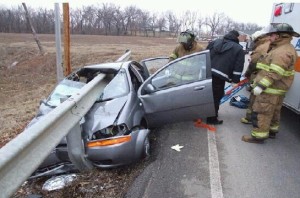The title is a bit facetious, of course not. The lack of responsibility and common sense involved in multi-tasking while driving is too big a risk for anyone, especially since the effects can rip someone’s world apart. But for those that continue to text and drive, the effects of having to keep on such keen alert in compensation for having split attention capacities on the road could train and sharpen reaction time based on time. However, the accuracy and consistency of reaction times for text-drivers has been supported by data to be simply abysmal. In a world where 77% of adults age 16-20 admit confidence in their ability to text and drive and 1 in 5 of them admit to surfing the web while driving, where does the risk outweigh the leisure? 2,700 teens each year die from reckless driving with alcohol, and another 3,000 from texting while driving. Does faster reaction time mean more safety? On paper this idea makes sense, but is it anything practical besides a side-effect of being irresponsible while driving?
In a study conducted by students at Texas A&M, forty-two drivers from 16-54 were chosen to take part in exercises that would accurately monitor their abilities to react safely and efficiently to road traffic. In one portion of the test, subjects were asked to write a somewhat lengthy text message on their smartphones at their leisure within a few minutes, with no real time limit. The second portion of the test involved a realistic mock-road test that monitored each subject’s reaction time responding to traffic lights in appropriate manners (stopping at red, turning, slowing at yellow etc.) while both driving normally and while attempting to read and respond to a random text message. On average, the texting portion of the driving test displayed data that cut the time of texters by almost a whole second compared to the average time it took them in the safe driving portion (which was 1.5-2 seconds). However, the texting portion supported that their inconsistency in safely responding- in many cases completely missing the lights or responding too late- meant nothing for the supposedly better reaction time. Also, this timed exercise does not fully describe the safety involved in driving. Stopping on a dime does not make a safe stop, and the extra second could mean many things in the perspective of the road with allowing other drivers to have an idea of what you’re doing so as to avoid accidents.

Sure, some people may be better at getting away with texting while driving, and may never have anything bad happen to them- but the numbers don’t show good odds.
One problem I noticed with the results of this study were the amount of variables that could play into affecting the reaction time. For example, a 16-year-old driver simply does not have as much driving experience as a 40-year-old, and different drivers could have slower or faster texting times that could affect their ability to text and quickly look back to the road. Luckily, the model of smartphone used was standardized so as to not further confound the data by comparing a 45 year old with a Razr punch-pad flip phone to a 17 year old with an iPhone 6. There were open sections of the roadway and barreled sections to simulate obstacles. By average, the characters-per-minute rate was 59.3 in the obstacles and 63.6 in the open sections, and the reading rate was 639 characters per minute in the obstacles and 709 on the open sections, literally half of the 1192 recorded as the control taken off the roads. The ~1 second off reaction time has no practical benefit behind the wheel of a car, and the inconsistency involved could cost someone their life, let alone an embarrassing fender-bender.
I think this test could be taken farther to monitor if there are types of cars of driving situations that most leave people the most susceptible to the temptation to text while they drive, or if there’s any correlation between amount of time spent on the road and the likelihood of texting at least once while driving. A cross-section survey could be helpful to support the data from the Texas A&M study, especially if it could follow the developments of younger drivers and their habits as they gain experience behind the wheel. Reaction time might be slightly faster, but its full attention that the road requires from everyone that we owe each other while we drive.
http://safety.trw.com/texting-while-driving-now-leading-cause-of-us-teen-deaths/0710/
http://www.csmonitor.com/USA/Society/2010/0923/Texting-caused-total-distracted-driving-deaths-to-rise-study-finds
Click to access textingdriving-study-100511.pdf
http://www.sciencedirect.com/science/article/pii/S000145751400178X

Texting while driving is definitely not worth it. I noticed the experiment you wrote about was about texting and driving, but what about breaking it down to just multitasking in general? This experiment was done with the hypothesis being as one continues multi-tasking over time, they could lose their ability to multi-task overall. This could be connected with texting and driving. Many people text while walk, text while listening to music, and text while talking to someone in person. If a person then goes and texts while driving, it could lessen their driving skills even more! Just something to think about.